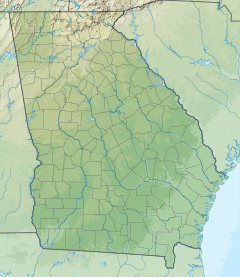 Front cover of the 1960 Masters Guide | |
| Tournament information | |
|---|---|
| Dates | April 7–10, 1960 |
| Location | Augusta, Georgia 33°30′11″N 82°01′12″W / 33.503°N 82.020°W |
| Course(s) | Augusta National Golf Club |
| Organized by | Augusta National Golf Club |
| Tour(s) | PGA Tour |
| Statistics | |
| Par | 72 |
| Length | 6,980 yards (6,383 m)[1] |
| Field | 83 players, 45 after cut |
| Cut | 150 (+6) |
| Prize fund | $87,050 |
| Winner's share | $17,500 |
| Champion | |
| 282 (−6) | |
| Location map | |
Location in Georgia | |
The 1960 Masters Tournament was the 24th Masters Tournament, held April 7–10 at Augusta National Golf Club in Augusta, Georgia. Arnold Palmer birdied the final two holes to win by one stroke over runner-up Ken Venturi.[2][3][4]
It was the second of Palmer's four Masters victories and the second of his seven major titles. Palmer, age 30, also won the U.S. Open in 1960 and was the runner-up at the British Open.
Jack Nicklaus, age 20 and the reigning U.S. Amateur champion, played in his second Masters. He made the cut for the first time at Augusta and tied for 13th place. Defending champion Art Wall Jr. did not play, due to a knee injury.[5] The purse was $87,050 with a winner's share of $17,500.[6]
Third place finisher Dow Finsterwald received a two-stroke penalty after the second round for violating a local rule, practice putting on the green following the conclusion of a hole, and lost the title by two strokes. The incident had occurred in the first round, and was self-reported after the second round after he was informed by his playing partner Billy Casper that it was not allowed. Instead of leading at 139 (−5), Finsterwald was tied with Ben Hogan and two others for second place after two rounds at 141, one stroke behind leader Palmer at 140.[7]
Palmer was the sole leader after all four rounds and was the second wire-to-wire winner at the Masters, following Craig Wood in 1941. Subsequent wire-to-wire winners were Jack Nicklaus in 1972, Raymond Floyd in 1976, and Jordan Spieth in 2015.
The 36-hole cut rule was slightly modified this year to include all golfers in the top 40 plus ties or within 10 strokes of the lead. Previously the cut rule at the Masters (instituted in 1957) was top 40 plus ties. Three golfers made the cut at 150 (+6) who would not have made the cut under the previous rule.
The Par 3 contest was introduced this year, and three-time Masters champion Sam Snead won with a score of 23 (−4).[5]
- ^ "Palmer's 72 keeps him 1-stroke up". Milwaukee Sentinel. UPI. April 10, 1960. p. 1-sports.
- ^ Wind, Herbert Warren (April 18, 1960). "Gasps for a fabulous finish". Sports Illustrated. p. 12. Archived from the original on December 13, 2013.
- ^ Gundelfinger, Phil (April 11, 1960). "Palmer's rally wins in Masters". Pittsburgh Post-Gazette. p. 1.
- ^ Bartlett, Charles (April 11, 1960). "Palmer's birdie-birdie finish wins". Spokesman-Review. Spokane, Washington. (Chicago Tribune).
- ^ a b "Snead cops Par-3 test at Masters". Milwaukee Sentinel. Associated Press. April 7, 1960. p. 6, part 2.
- ^ "Palmer's blazing finish wins Masters by one". Milwaukee Sentinel. Associated Press. April 11, 1960. p. 2, part 2.
- ^ Grimsley, Will (April 9, 1960). "Finsterwald penalized, Palmer's 140 tops Masters; Hogan tied for second". Youngstown Vindicator. Ohio. Associated Press. p. 10.

